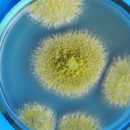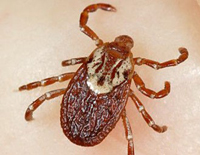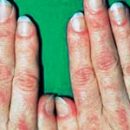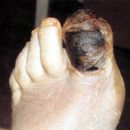What is Tularemia? What are the sources of infection? What are the symptoms of Tularemia? How to diagnose the disease? Answers to these questions you will find in the article.
Content
Tularemia
Tularemia -
Naturally focal infectious disease with lymphatic lesions
nodes, skin, sometimes eyes, oz and lungs accompanied by
pronounced intoxication.
This infection is widespread
In the countries of Europe, Asia and North America. On the territory of the Russian
Federation there are a large number of foci.
Pathogen
Tularemia - Bacteria Francisella (Francisella Tularensis). She
sufficiently stable in the external environment, but when boiling dies through
1-2 minutes. The main source of infection - rodents (ondatras, rats, mice,
Susliki, hares). Quite often infected hunters, farmers,
fur harvesters, butchers - with contact with infected animals, with
Cutting Tush.
Sources of infection
Carriers
Tularevia are bloodsowing insects, the pathogen can also
penetrate the intact skin or through the lungs - when inhalation
dust, possibly mass infection through poorly cooked
food and contaminated water - that is why tularemia is considered
As likely biological weapons. Sick man danger
for others does not represent, although the susceptibility of people to this
infections are very high.
Symptoms of Tularemia
The clinical form of the disease depends on the path of penetration. Incubation period - from 1 to 30 days (more often than 3-7 days).
Usually
The disease begins acutely, with headaches, nausea, vomiting, temperature
Body quickly rises to 39-40°C, chills appears. Face and Neck Leather
blushing, poured blood vessels conjunctiva. A rash appears,
which to the 8-12th day of the disease peels off, after it can stay
Skin pigmentation.
Later, more specific lesions arise, depending on the path of penetration of the pathogen:
 Bubonne form
Bubonne form
It occurs if the introduction of microbes happened through the skin. Increase
Nearest lymph nodes (in the form of bubes), later in the process
Remote nodes can be involved.
- Journal-bubonic
The form develops more often when infecting insect bite. In addition to Bubon
A shabby ulcer with raised edges appears at the bite,
Dark crust covered.
- Eye-bubonic
Form - when penetrating the pathogen through the conjunctival. Characteristic
Erosions and ulcers of conjunctivations with a yellow pus separation, sniffing buboons
Lymph nodes.
- Angic-bubonic
Form - when using infected water and food. Proceeds in the form
Heavy thoughts with necrosis of almonds, bribes in the submandibular, cervical
and nearly surround areas.
- Abdominal
The form develops due to the lesion of the lempatical vessels of mesen.
Manifests strong pain in the stomach, nausea, vomiting, sometimes
- diarrhea.
- Lungy The form arises
When inhaling the pathogen. Lymph nodes of trachea, bronchi
and mediastinum (easier option), or focus developing
Pneumonia (proceeds quite hard and has a tendency to development
complications).
- Generalized form
Reminds severe sepsis. Symptoms of intoxication are expressed: heavy
Fever, weakness, chills, headache. Confusion may occur
Consciousness, Brad, Hallucinations. Perhaps the appearance of a rack rash throughout
body, bubones of various localizations, pneumonia. This form maybe
complicate infephonic toxic shock.
Diagnosis of Tularemia
Diagnostics
Tularemia in the first days of the disease presents significant difficulties.
Help the doctor may reference to contact with rodents and t.D. Diagnosis
clarify with the identification of serum antibodies to the causative agent
and skin-allergic samples with Tulyarin. Valuable diagnostic method
is an PCR (polymerase chain reaction).
Tularemia
treated under an infectious hospital. The main component
Therapy - antibiotics that are applied by a long course.
Also carry out disintellation and anti-inflammatory therapy,
The need to maintain the functions of the internal organs.
Large abscesses arising from the suppuration of lymph nodes are opened and drained.
Mortality
the absence of appropriate treatment is 6%, death comes
As a result of generatization of infection. At the passing Tularemia
remains steady lifelong immunity.
Prevention of the disease
In endemic areas, comes down to fighting rodents. If in animals
Tularevia is found, the population is carried out preventive
Vaccinations.









